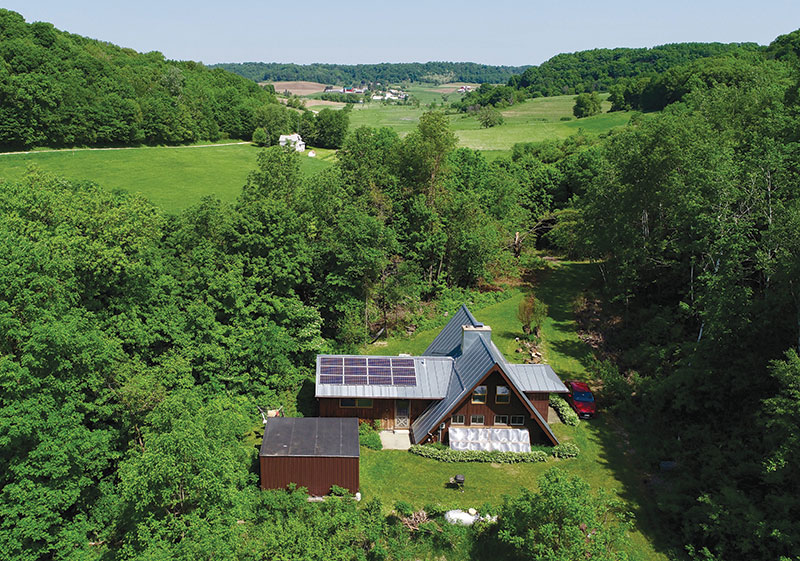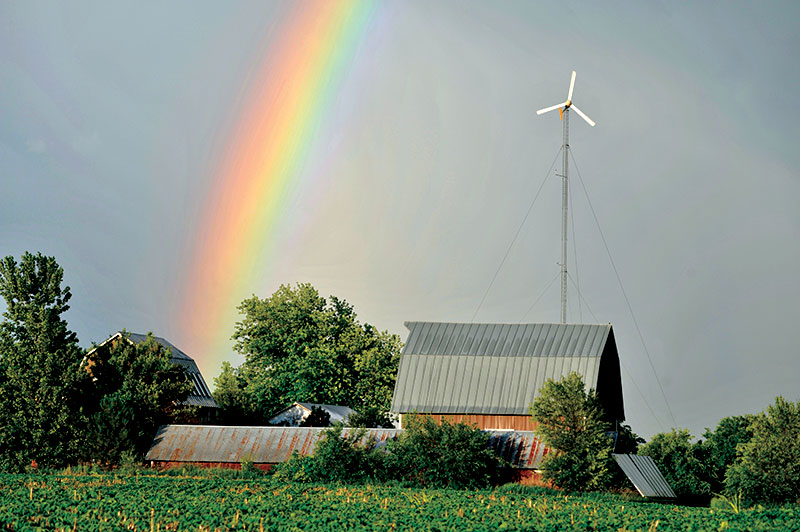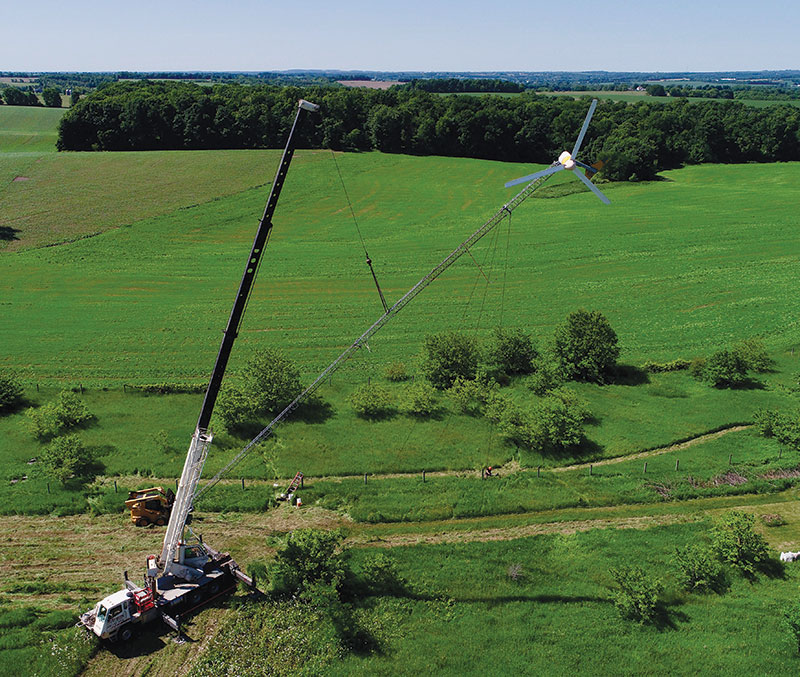
You can harness the power of the sun on your farm or small homestead in many ways. Generating your own power with a solar electric (photovoltaic) or wind turbine system can help your operation become a producer of energy in the same way as being a producer of food or fiber. Depending on the size of the system and how much energy your operation needs to run, such systems could result in eliminating your electricity bill—or even getting a refund from your local utility, like we do.
By living “off the grid,” we don’t mean disconnecting from it. Rather, use the grid as a more affordable and convenient storage for electricity generation. Only on rare occasions—for remote properties or for hardcore survivalists—does a truly off-grid system make economic sense because of the ongoing battery costs needed to store electricity.
There’s no reason why adding a renewable energy system should be any different or more difficult than adding a hoop house or purchasing a tractor. Sure, you’ll have to learn some new jargon, consider some technical aspects and, of course, make an investment. But after some initial groundwork, you could power your farmstead with renewable energy in a matter of months. (You can also consider leasing land to solar developers.) From a financial perspective, moving on such a system is timely: Many federal and state incentives for such systems are set to expire or be phased out in the coming years.
Put Conservation & Efficiency First
Regardless of the renewable energy system you consider, you should first evaluate every aspect of your farm and home energy use. Conservation and using energy-efficient equipment are far more cost effective than adding a renewable energy system, often by a ratio of three to one; for every $1 spent on efficiency, you would need to commit $3 in renewable energy generation expense. Examine each appliance and make sure it’s energy efficient. Appliances should be Energy Star certified or sized appropriately to their use. All lighting should be LED or compact fluorescent.
Next, explore ways to conserve energy on your farm. Can you skip air conditioning and rely instead on fans? Perhaps you already line-dry laundry rather than use an energy-hogging clothes dryer. Are your refrigerator and freezer full, or can you pull the plug on one that’s seldom used? While not the scope of this article, you can also decrease energy use and utilize the abundant sunshine where you live by installing a solar thermal system. Such systems collect heat from the sun and put that energy into heating water or warming your home through an in-floor radiant system. The same can be said for heating with wood with an EPA-certified woodstove if you live where downed hardwood trees are readily available.
In your evaluation, consider the energy you might use in the future. Many people who have installed such systems have switched to various rechargeable power tools, mowers and even plug-in electric vehicles.
The farmstead total energy use, or the load, is summarized by your local utility in kilowatt-hours by month on your bill. You need this information to determine the size of your system to meet your needs once you’ve exhausted conservation and efficiency efforts. If you operate a fresh vegetable CSA and have a cooler or find yourself freezing lots of your meats, your load might require a substantially larger renewable energy system.
Renewable Energy Systems Basics
Regardless of whether you want a renewable energy system to reduce or eliminate your electric bill, reduce pollution from the burning of fossil fuels or help mitigating the effects of climate change, generating your own power on a farm is a great step to boosting self-reliance and sustainability.
You’ll install a system comprising various pieces of equipment that work seamlessly together. Because of off-grid systems’ battery cost and maintenance hassles, most farmers opt for a grid-tied system whereby they can use the grid as a backup to “bank” their surplus generation when they producing more than they use during a specific time.
When your system doesn’t meet your electricity needs, you just pull electricity from the grid like normal. Often, a bidirectional meter is installed to track this process, though nothing will appear any different in the home; your lights will not flicker or dim. Because of changes in what utilities pay for surplus generation, most systems are sized based on the electricity needs of the farmstead; there is no benefit to overproduce.
A solar electric system includes four key components:
- photovoltaic (PV) panels,
- an inverter that connects via your farm service “main” panel to the utility grid,
- a rack system to connect the modules safely to a structure, and
- what’s known as the “balance of system,” which refers to the rest of the wires, breakers and lightning arrestors that make your system safe and to code.
With a wind turbine system, a turbine replaces the modules to produce electricity, with the turbine placed on a tower, not a rack. An inverter converts the electricity generated by the system into a utility frequency alternating current to match what is provided by the utility and used by your appliances.
The size of a system is quoted by the rated production, in kilowatts (kW), of the wind generator or combined group of PV modules (called a solar array). To make it confusing, what you produce, however, is measured in kilowatt-hours (kWhs). A 10-kW wind turbine might produce, at a certain site, 10,000 kWhs a year; but a 10-kW solar array might produce 13,000 kWhs at the same site, based modules are angled and so forth.
Every system is unique, sized to meet the farm needs or budget, and appropriate for the site, geographic location and energy production potential. The great news? Most companies you’d hire do much of the site assessment and sizing of the system as a part of providing a quote for the project. These installers use various tools and national data to make remarkably accurate determinations of production by month and year for your site.
With the increasing number of renewable energy systems being installed nationwide, it’s becoming easier to put one in. For either type of system, you need an interconnection agreement with your local utility because you’ll use the grid to store your surplus generation. The utility, rightly so, wants to make sure your system is installed following the latest electric codes and safety protocols. Again, the installer you choose might assist with this process, especially with any technical details that sometimes can involve electric diagrams. You’ll probably be required to carry $300,000 in liability insurance, which, for most homeowners or farmers, might be covered under your existing policy.
Power from the Sun
A vast portion of the U.S. receives plenty of sunshine on a regular enough basis to make a PV system cost effective. Sure, it’s sunny only during the day and when the PV system is producing, but that’s when most energy is used. In the evening and on cloudy days, any electricity needs beyond what the system provides comes from the grid.
The PV panels can be added on top of an existing roof, placed on a fixed rack in a field or cantilevered off the side of an outbuilding. Each design has a different racking configuration. A standing-seam roof permits a low-cost clamping rack system to be used; mounting an array on a rack in a field costs more and requires excavation, cement and posts. The wire run is usually trenched and underground to an area near the farmstead electric service main panel.
Most farm installations feature a fixed rack system in an open field, facing south, with few, if any, obstructions such as trees or other buildings. An installer will carefully examine the site to evaluate potential shading issues using a Solar Pathfinder device. As you know, the sun not only moves across the sky during the course of the day, it also changes position in the sky throughout the year. Each variable affects what the system can produce, in addition to the size of the system in terms of the panels and their rated power (in Watts).
Thanks to the significant decrease in prices for PV modules over the last decade, solar electric systems have become much more affordable. Because there are few moving parts, unlike a wind turbine, PV systems are more reliable and relatively maintenance-free. Most systems now have monitoring built into the system so you can track the production on a daily basis—even from a smartphone.
When you install a PV system as an investment in equipment that’s part of your business, your investment is done with pretax revenue, and the system can be depreciated in part or full under IRS Section 179, accelerating your payback window. Depending on where you live, a system to power a small farm with about 10,000 kWhs can cost $20,000 to $45,000, after incentives.
Beyond the scope of this article, there is a wide selection of PV modules as well as inverters and rack manufacturers, with many made in the U.S., Europe and China. Generally, it’s wise to stick with manufacturers that have been around for a decade or more and offer material or workmanship warranties that last the longest.
For PV modules, manufacturers focus on panel efficiency: how well the panel converts sunlight into electricity. The higher the efficiency rating, the better; stick with those that offer PV performance warranties, meaning that in 10 years, if your modules are not producing what they should be, you can get them serviced or replaced.
Power from the Wind
In some parts of the country, windy days seem to never cease—along coastal areas, high atop ridgelines or in wide open plains. For these locations, a wind turbine might be a great option to generate electricity, especially if you own enough land to erect a tower and have neighbors who might not object. Your site should have an average annual wind speed of at least 10 mph for the best return on your investment.
Besides sizing your turbine and inverter, you need to decide how high and what type of tower you can afford. Energy production is then based on the combination of these equipment variables, plus the size of your turbine blades and the wind resource at your site, which, as it turns out, can vary significantly depending on the season. In many parts of the country, fall, winter and spring tend to be significantly windier than the summer months.
The higher your tower, the more consistent and less turbulent the wind is. Wind turbulence and variability diminish generation and wear your machine down quicker. Wind turbines are more common in rural areas, especially on properties of five acres or more because it’s best to have the so-called “fall line” of the turbine (in the rare event that it would fall to the ground) to rest only on your property and not a neighbor’s land or a public road. This avoids the headaches of zoning easements or variances. Most wind turbines on small farms are on 100-foot or 120-foot towers, which come in three basic types in order of least to most expensive: guyed-lattice, lattice and tilt-up.
Wind turbines located at particularly windy sites can be very successful at producing large amounts of renewable energy, sometimes continuously for days. For example, a 10-kW wind turbine generating about 8 kW/hour for just 48 hours results in 384 kWhs. Such production comes at a cost. Because of the girth of the system and metal involved, plus the more involved installation process requiring cranes and long trenching runs (few people want a turbine right outside their door), a small-farm-sized (10-kW) system can cost $50,000 to $80,000.
A wind turbine can have a few negative points. Of course, it’s not always windy. Because of its design, number of moving parts and placement in harsh climates, wind turbine systems are more likely to require routine maintenance and experience a significant failure. In a severe windstorm, blades could crack. A bolt of lightning from a passing thunderstorm could hit the tower. While plenty of safety measures exist for wind turbine systems, unforeseen issues do arise that result in damage and downtime. Each event, of course, eats into your production and adds to the cost of the system, not to mention frustration and stress. While wind turbines can be very effective at generating electricity, you should be ready after every storm to check your system to make sure it’s operating as it should.
Mini-Case Example

Wind Turbine at Inn Serendipity Bed & Breakfast and Farm
- Installation Year: 2003
- Size: 10-kW, Bergey Excel-S wind turbine on 120-guyed lattice tower, 300 feet from farmhouse
- Annual Production: 9,966 kWhs/year on average (over-producing about
3,000 kWhs/year) - Net cost after incentives: $23,870
- Incentives received: $15,595 in state grant (in-kind support also used as matching funds). The system was also depreciated under IRS Section 179, because it’s owned by the business.
- Maintenance: Numerous small issues, such as replacing inverter fan and fuses; catastrophic blade failure after wind storm and blades had to be replaced.
- (Actual yearly production data available here.)

Power Up
Check out these resources and funding options for renewable energy projects when considering alternative energy ideas for your farm.
- Midwest Renewable Energy Association. Hosting the nation’s longest running renewable energy fair.
- The Homeowner’s Guide to Renewable Energy, Solar Electricity Basics and/or Wind Power Basics, all by Dan Chiras
- Database of State Incentives for Renewables & Efficiency. A national listing of state and federal grants, special loans and other incentives for renewable energy systems. www.dsireusa.org
- Federal Solar Tax (Investment Tax Credit) Credit. For businesses and individuals, there is currently a 30 percent federal tax credit for the installation of renewable energy systems. https://bit.ly/2slQxHu
- USDA Rural Development: Rural Energy for America Program. REAP is a competitive grant and loan program is for agricultural producers and rural small businesses. Grants can cover up to 25 percent of the project cost.
There’s nothing better than boosting your farm’s bottom line by eliminating your electric bill and an expense line in your business income statement. An investment in renewable energy makes your operations more self-reliant and sustainable while offering the ability to head off inflation and reinforce your commitment to the environment.
This article appeared in Living Off the Grid, a 2018 specialty publication produced by the editors and writers of Hobby Farms magazine. Aside from this piece on renewable energy, Living Off the Grid includes stories on permaculture, growing plants without seeds and long-term produce storage. You can purchase this volume, Hobby Farms back issues as well as special editions such as Best of Hobby Farms and Best of Urban Farm by following this link.




